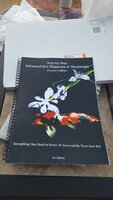frederick thompson
Member
First of all a little about my self. i have kept fish all my life. But KOI for 22 years
i have a 4000 gallon outside pond. upper pond and lower pond.
2 x windows. 2 x pumps . bottom drain. 2 x Lines. one line is skimmer to 78 micron mesh Ultra sieve to 8000 LPH Pump to 50 watt UV to Tangible Pond Returns 2 feet of the bottom of pond .
Line 2 Bottom Drain to Automated Rotary Drum inside a nexus 320. which has moving K 1 as bio side.
to 8000 gallon LPH pump to 55 watt UV to upper pond . waterfall by shute to lower pond
2 x Air pumps. One for bottom drain. and one for moving the K1 in the Nexus
A few all ready know of me . i had a new pond build and revamp on my garden last year. i was advised to put this thread on a blog on it s own. so here it is.
i have done a lot of the medical stuff myself. and saved quite a few fish. i am not a vet. and do not claim to be.
if people are not confident with some of the stuff in this thread . my advice is see a vet.
this book is brilliant for people who keep fish for medical treatments and water keeping

HOW TO ANAESTHESIA AND HOW TO TOPICAL TREAT A BACTERIAL WOUND
1 Have all your kit ready tools scalpel, tweezers, scissors, cotton buds, surgical rubber gloves. wet towels. tissue.
and medical stuff 1 x 150ml of Kusuri Masuizai Koi Sedate. 1 x 100ml Kusuri Roccal Wound Cleaner 1 x 100ml Kusuri Anti-Bac 1 x 25gms of Kusuri Orahesive Sealer Powder
1 x 50ml Kusuri Top Coat Sealer
thats basicly the kit you need ready before sadating
to sedate the fish use the Kusuri Masuizai Koi Sedate
to make sure it has gone under, or as i phrase it knocked out, watch muscle movement. it should look like this

here is what a ulcer wound looks like

now for the topical treatment next
i have a 4000 gallon outside pond. upper pond and lower pond.
2 x windows. 2 x pumps . bottom drain. 2 x Lines. one line is skimmer to 78 micron mesh Ultra sieve to 8000 LPH Pump to 50 watt UV to Tangible Pond Returns 2 feet of the bottom of pond .
Line 2 Bottom Drain to Automated Rotary Drum inside a nexus 320. which has moving K 1 as bio side.
to 8000 gallon LPH pump to 55 watt UV to upper pond . waterfall by shute to lower pond
2 x Air pumps. One for bottom drain. and one for moving the K1 in the Nexus
A few all ready know of me . i had a new pond build and revamp on my garden last year. i was advised to put this thread on a blog on it s own. so here it is.
i have done a lot of the medical stuff myself. and saved quite a few fish. i am not a vet. and do not claim to be.
if people are not confident with some of the stuff in this thread . my advice is see a vet.
this book is brilliant for people who keep fish for medical treatments and water keeping
HOW TO ANAESTHESIA AND HOW TO TOPICAL TREAT A BACTERIAL WOUND
1 Have all your kit ready tools scalpel, tweezers, scissors, cotton buds, surgical rubber gloves. wet towels. tissue.
and medical stuff 1 x 150ml of Kusuri Masuizai Koi Sedate. 1 x 100ml Kusuri Roccal Wound Cleaner 1 x 100ml Kusuri Anti-Bac 1 x 25gms of Kusuri Orahesive Sealer Powder
1 x 50ml Kusuri Top Coat Sealer
thats basicly the kit you need ready before sadating
to sedate the fish use the Kusuri Masuizai Koi Sedate
to make sure it has gone under, or as i phrase it knocked out, watch muscle movement. it should look like this
here is what a ulcer wound looks like
now for the topical treatment next




